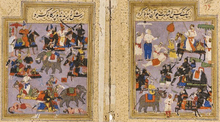Battle of Talikota
| Battle of Talikota | |||||||
|---|---|---|---|---|---|---|---|
| Part of Muslim conquest in the Indian subcontinent | |||||||
| |||||||
| Belligerents | |||||||
| Vijayanagara Empire | |||||||
| Commanders and leaders | |||||||
| |||||||
| Strength | |||||||
|
80,000 infantry (Beydurs)[1] 30,000 cavalry[1] several dozen artillery cannons[1] | 140,000 foot, 10,000 horse and over 100 War elephants[1] | ||||||
The Battle of Talikota (23 January 1565) was a watershed battle fought between the Vijayanagara Empire and the Deccan sultanates. The battle took place at Talikota, today a town in northern Karnataka, about 80 kilometres (50 mi) to the southeast from the city of Bijapur. The treacherous defeat of Vijayanagara Empire, followed subsequent destruction and looting which became short lived before the successors of Rama Raya.
The battle

The Muslim Sultanates to the north of Vijayanagara united and attacked Rama Raya's army, on 23 January 1565, in an engagement known as the Battle of Talikota.[2] The armies clashed on the plains near the villages of Rakkasagi and Tangadigi (it is also known as the Battle of Rakkasa-Tangadi).[3]
The Vijayanagara army was winning the battle, state Hermann Kulke and Dietmar Rothermund, but suddenly two Muslim generals of the Vijayanagara army switched sides and turned their loyalty to the united Sultanates. They captured Rama Raya and beheaded him on the spot, with Sultan Hussain on the Sultanates side joining them.[4][5] The beheading of Rama Raya created confusion and havoc and in the still loyal portions of the Vijayanagara army, which were then completely routed. The Sultanates' army plundered Hampi and reduced it into ruins.[6]
Assessment of the battle's outcome

According to Shastri, the greatest factor was the betrayal of the Vijaynagara Army by two Muslim commanders (Gilani Brothers). At the critical point of the war, Muslim officers in the Vijayanagara army launched a subversive attack. Suddenly Rama Raya found himself surprised when the two Muslim divisions in his ranks turned against him.[8]
Robert Sewell, in his book The Forgotten Empire, concludes thus – "With fire and sword, with crowbars and axes, they carried on day after day their work of destruction. Never perhaps in the history of the world has such havoc been wrought, and wrought so suddenly, on so splendid a city; teeming with a wealthy and industrious population in the full plenitude of prosperity one day, and on the next seized, pillaged, and reduced to ruins, amid scenes of savage massacre and horrors beggaring description."[9]
See also
References
- Eaton, Richard M. (2006). A social history of the Deccan, 1300–1761: eight Indian lives. Cambridge: Cambridge University Press. ISBN 978-0-521-71627-7.
- Dr. Suryanath U. Kamath, A concise history of Karnataka, 2001, Bangalore (Reprinted 2002)
- Prof K.A. Nilakanta Sastri, History of South India, From Prehistoric times to fall of Vijayanagar, Oxford University Press, New Delhi (1955; reprinted 2002)
- Robert Sewell, A Forgotten Empire: Vijayanagar; A Contribution to the History of India
Notes
- 1 2 3 4 India Today Collector's edition of History
- ↑ Eaton 2006, pp. 96–98.
- ↑ Sen, Sailendra (2013). A Textbook of Medieval Indian History. Primus Books. p. 110. ISBN 978-9-38060-734-4.
- ↑ Hermann Kulke; Dietmar Rothermund (2004). A History of India. Routledge. p. 191. ISBN 978-0-415-32920-0. , Quote: "When battle was joined in January 1565, it seemed to be turning in favor of Vijayanagara - suddenly, however, two Muslim generals of Vijayanagara changes sides. Rama Raya was taken prisoner and immediately beheaded."
- ↑ Eaton 2006, pp. 98, Quote: "Husain (...) ordered him beheaded on the spot, and his head stuffed with straw (for display).".
- ↑ Eaton 2006, pp. 98–101.
- ↑

- ↑ K A Nilakanta Shastri History of South India p. 267
- ↑ "A Forgotten Empire: Vijayanagar; A Contribution to the History of India".